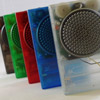FM3, “Buddha Machine 3 (Chan Fang)”
 In its fourth iteration (including the Gristleism special edition), the duo of Christiaan Virant and Zhang Jian have once again created a small box of rudimentary loops that, in its increased technological capacity, has somewhat diminishing returns.
In its fourth iteration (including the Gristleism special edition), the duo of Christiaan Virant and Zhang Jian have once again created a small box of rudimentary loops that, in its increased technological capacity, has somewhat diminishing returns.
At first glimpse, it’s not hard to see the progress made from the first unit. Gone is the faux ethnic packaging from the first or the Spartan cardboard from the second. Instead, a minimal printed plastic sleeve covers the tinted, transparent boxes. The headphone jack and pitch adjustment are still here, but the most drastic changes come in the form of what's actually encoded within the unit.
Rather than the lo-fi textures of the previous models, Chan Fang features fewer (only four) loops, but longer ones constructed only using the Qin, a traditional Chinese stringed instrument. The result is sparse, plaintive tones that seem to resonate with even greater digital clarity than heard in the previous versions, which is where I was a bit underwhelmed.
I was fond of the chintzy speakers and audio flaws that were present in the older models, which gave them a distinct character. Here it’s almost too clean, too "pretty" for lack of a better word. Even with the pitch adjustments, the tones stay close to their classical roots.
While the previous Buddha Machines were designed to mimic the soundboxes used by Buddhist monks during meditation, the abstract drones took on a quality and use all their own. Here, it almost seems too practical, where the box could be placed in any office setting and allowed to play without anyone complaining.
Chan Fang, which translates to "zen room," is an apt title that follows the tradition of the Buddha Machine series, but for me it's too slick and too well done. As a practical object, it excels more than any of the previous versions have, providing a simple, unobtrusive ambience to any situation. As a toy for creation or experimentation, the sound is a bit limited and monochromatic.



